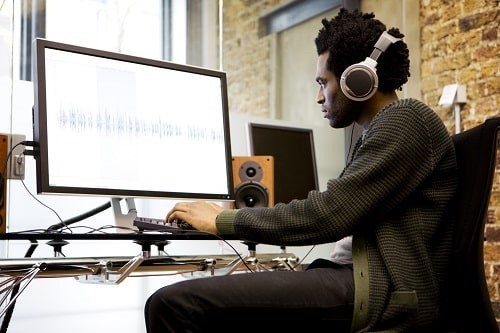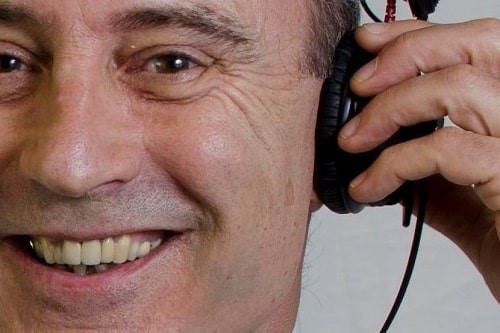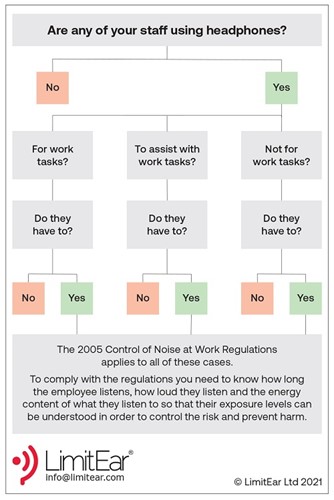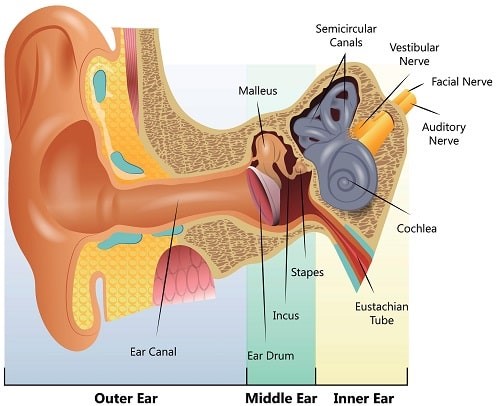Workers could be damaging their hearing when wearing headphones and headsets for work purposes and to listen to music while working, so it’s vital employers take steps to control the risks.
Features
Sound advice
Over the past 15 years or so, since the latest Control of Noise at Work Regulations came into force, most employers responsible for noisy workplaces have been aware of their legal duty to protect their employees’ hearing from high levels of noise. Noise can be defined as sound which you don’t want to hear, such as that from a loud machine or tool. In such workplaces, hearing protection and other control measures – including exposure monitoring and health surveillance – have become commonplace.
What many people do not appreciate is that the exposure to ‘sound’ – defined as something you do want to hear, like the spoken word or music – from headphone and headset use can be equally as damaging to your hearing as unwanted occupational noise generated as a by-product of work processes.
 Employers who ignore the challenges of headphone use at work risk enforcement action, potential prosecution and civil liability through employee claims for hearing damage. Photograph: iStock
Employers who ignore the challenges of headphone use at work risk enforcement action, potential prosecution and civil liability through employee claims for hearing damage. Photograph: iStock
In headline terms it doesn’t matter if your exposure is to noise or to sound; the harmful energy and potential for hearing damage is the same.
Worryingly, according to a 2015 report by the World Health Organization (WHO), more than 1.1 billion young people are already at risk of permanent hearing loss, globally, due to unsafe listening practices. The WHO reported that:
- “Nearly half of all teenagers and young adults (12 to 35 years old) in middle- and high-income countries are exposed to unsafe levels of sound from the use of personal audio devices…” (headphones)
- “That 50 per cent of users that listen to music over personal audio devices follow unsafe listening practices.”
Reproduced sound in the workplace
High levels of workplace noise are usually very obvious by their nature (think of a pile driver during building construction, for example). However, reproduced sound created from electronic devices (which is listened to through headphones or headsets), is highly variable in terms of content and level and can be more difficult to identify as a risk.
It can therefore also be more difficult to measure and manage. Listening to music or reproduced sound at a typical volume can potentially use your permitted daily sound allowance in less than 60 minutes.
 Stephen Wheatley, Director and trustee UK Hearing Conservation Association
Stephen Wheatley, Director and trustee UK Hearing Conservation Association
Because reproduced sound is a less obvious risk in workplaces it is often easy to accumulate an excessive sound dose without realising it. Understanding that this sound exposure is equally as harmful as noise exposure means that protecting your hearing when using headphones or headsets is vital.
Safeguarding technologies are becoming more widely available and accessible for a wide variety of different types of headphones, headsets and in-ear devices. They work by providing the user with the information on sound dose levels and listening times. This crucial information enables the user to manage their exposure to sound and control the exposure, if required, to ensure their hearing is protected in line with the Noise at Work Regulations.
If, in addition to using headphones for recreational use, a worker uses headsets and/or headphones for work purposes, this increases their sound dose dramatically. This makes it even more important for the employer to make sure they provide adequate controls to protect workers from the risk of hearing damage. This may include providing and using appropriate technologies that safeguard the hearing of their employees who use headphones.
Some examples of occupations which require the regular use of headphones include:
- Film production
- Broadcasting
- Music production
- Live events
- Sound editing
- Contact centres
- Interpreters
- Blue light services
- Aviation
As well as situations where employees are required to wear headphones due to the nature of their work, many employers also permit their employees to use their own personal music players with headphones while at work. What is not often appreciated is that the employer also has a responsibility to ensure that users in this second category are also protected from the risk of hearing damage in line with the Noise at Work Regulations.
Examples of non-occupational headphone use at work include:
- Listening to music from a PC/smartphone or tablet
- Watching videos
- Playing eSports or gaming.

How do we hear?
We can hear sound because of vibrations (sound waves) that enter our ears. We decipher these vibrations to hear speech, music or other sounds.
The outer ear directs sound waves into the ear canal. The sound waves travel through the ear canal to reach the eardrum.
 The average person is born with about 15,000 important hair cells within their cochlea and these cells are vulnerable to damage. Photograph: iStock
The average person is born with about 15,000 important hair cells within their cochlea and these cells are vulnerable to damage. Photograph: iStock
The eardrum vibrates from the incoming sound waves and sends these vibrations to three tiny bones in the middle ear. These bones amplify the sound vibrations and send them to the inner ear.
The inner ear contains a structure filled with fluid called the cochlea. Sound vibrations create waves in the cochlear fluids.
As the waves peak, they cause tiny hair cells within the cochlea to bend, which convert the vibrations into electrical signals interpreted by the brain through the auditory nerve.
The average person is born with about 15,000 of these important hair cells within their cochlea. These cells are the critical point where the physical noise energy is converted to allow your brain to detect and interpret the sound. These hair cells are also very vulnerable to damage by excessive noise. By the time you notice hearing loss, many hair cells have already been destroyed and cannot be repaired or replaced.
Repeated exposure to high sound dose can destroy many hair cells. Because we tend to lose the outer hair cells through cochlea damage first, these are the parts of our hearing function that allow us to distinguish frequencies in sound and therefore give us the quality of speech or music. This is why early hearing loss tends to affect our ability to distinguish and understand speech, particularly when there is background noise.
Eventually, if hearing loss continues, it can become hard to understand speech even in quieter places. In addition to damaging hair cells, repeated exposure to high sound doses can also damage the auditory nerve that carries information about sounds to your brain. Again, early damage may not show up on your hearing test. It can create a ‘hidden hearing loss’ that may make it difficult for you to understand speech in noisy places.
Key messages
- Individuals run a significant risk of permanently damaging or losing their hearing through exposure to reproduced sound in the workplace
- Employers have an obligation under the Control of Noise at Work Regulations 2005 to make sure that their employees are not over exposed to sound as well as noise. This applies equally to those who are required to wear headphones for their job and those who are permitted to wear personal listening devices during work time
- Employers who ignore the challenges of headphone use at work risk enforcement action, potential prosecution and civil liability through employee claims for hearing damage
- Employers must understand that sound from headphone and headset use can be as damaging as noise exposure and that the same principles should apply for risk assessment, control and monitoring performance.
Conclusion
Continuing to use headphones without protection and without understanding exposure levels will inevitably lead to a huge increase in permanent avoidable hearing damage among users.
Why you should take control now:
- Individuals should be informed about the risks and empowered to protect their own hearing, as once damaged it will never recover
- Employers need to make sure that they are fulfilling their legal obligations to protect the hearing of their employees and, by doing so, you will not only improve your operations but also your financial performance.
The flowchart on this page can help you decide how to take action to control the risk of hearing damage from workers using headphones, both for work tasks and personal reasons. It’s available at: bit.ly/3ky9rY4
For more information and advice see:
https://hearingconservation.org.uk
Stephen Wheatley is Director and trustee at the UK Hearing Conservation Association, Digital lead, Make Listening Safe campaign of The World Health Organization and CEO and founder LimitEar Limited.
This article was reviewed by Clare Forshaw, Chair of the UK Hearing Conservation Association and Occupational health and hygiene partner at Park Health
FEATURES

Sedentary working and how to combat the ‘sitting disease’
By Gavin Bradley, Active Working on 05 April 2024
Prolonged and excessive sitting poses a major risk to our health, but the Get Britain Standing campaign and On Your Feet Britain Day on 25 April are a great way of encouraging workers to sit less and move more.

Company culture and wellbeing: a crucial link
By Bex Moorhouse, Invigorate Spaces on 05 April 2024
Investing in measures to support worker wellbeing will be ineffective unless the company culture genuinely incorporates values like teamwork, involvement, flexibility and innovation.

Office design and culture: happier and healthier staff – or the opposite?
By Guy Osmond, Osmond Ergonomics on 03 April 2024
Applying ergonomic principles to workstation set-ups and ensuring the physical environment supports neurodivergent people are just some of the ways of creating an office where everyone can thrive, but a supportive and positive organisational culture is vital too.


